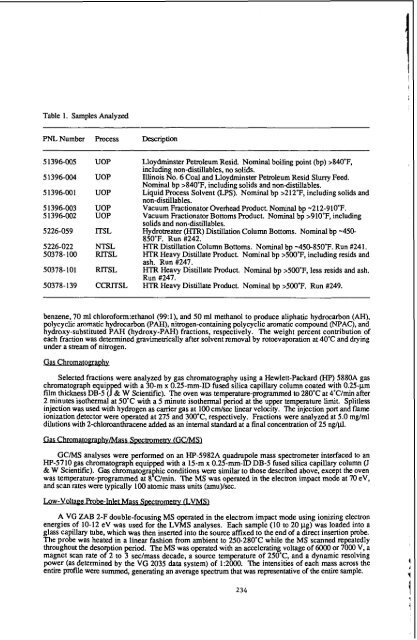Liquefaction co-processing of coal shale oil at - Argonne National ...
Liquefaction co-processing of coal shale oil at - Argonne National ...
Liquefaction co-processing of coal shale oil at - Argonne National ...
You also want an ePaper? Increase the reach of your titles
YUMPU automatically turns print PDFs into web optimized ePapers that Google loves.
Table 1. Samples Analyzed<br />
PNLNumber Process Description<br />
5 1396-005<br />
51396-004<br />
51396-001<br />
5 1396-003<br />
51396-002<br />
5226-059<br />
5226-022<br />
50378-100<br />
50378-101<br />
50378-139<br />
UOP<br />
UOP<br />
UOP<br />
UOP<br />
UOP<br />
lTSL<br />
NTSL<br />
RITSL<br />
RlTSL<br />
CCRITSL<br />
Lloydminster Peholeum Resid. Nominal b<strong>oil</strong>ing point (bp) >840"F,<br />
including non-distillables, no solids.<br />
Illinois No. 6 Coal and Lloydminster Pemleum Resid Slurry Feed.<br />
Nominal bp >840"F, including solids and non-distillables.<br />
Liquid Process Solvent (LPS). Nominal bp >212'F, including solids and<br />
non-distillables.<br />
Vacuum Fraction<strong>at</strong>or Overhead Product. Nominal bp -212-910'F.<br />
Vacuum Fraction<strong>at</strong>or Bottoms Product. Nominal bp >910'F, including<br />
solids and non-distillables.<br />
Hydrotre<strong>at</strong>er (HTR) Distill<strong>at</strong>ion Column Bottoms. Nominal bp -450-<br />
850'F. Run #242.<br />
HTRDistill<strong>at</strong>ion Column Bottoms. Nominal bp -450450°F. Run #241.<br />
HTR Heavy Distill<strong>at</strong>e Product. Nominal bp >500'F, including resids and<br />
ash. Run #247.<br />
HTR Heavy Distill<strong>at</strong>e Product. Nominal bp >500'F, less resids and ash.<br />
Run #247.<br />
HTR Heavy Distill<strong>at</strong>e Product. Nominal bp >500T. Run #249.<br />
benzene, 70 ml ch1or<strong>of</strong>orm:ethanol (99:1), and 50 ml methanol to produce aliph<strong>at</strong>ic hydrocarbon (AH),<br />
polycyclic arom<strong>at</strong>ic hydrccarbon (PAH), nitrogen-<strong>co</strong>ntaining polycyclic arom<strong>at</strong>ic <strong>co</strong>mpound WAC), and<br />
hydroxy-substituted PAH (hydroxy-PAH) fractions, respectively. The weight percent <strong>co</strong>ntribution <strong>of</strong><br />
each fraction was determined gravimemcally after solvent removal by rotoevapor<strong>at</strong>ion <strong>at</strong> 40°C and drying<br />
under a stream <strong>of</strong> nitrogen.<br />
Bas Chroma-<br />
Selected fractions were analyzed by gas chrom<strong>at</strong>ography using a Hewlett-Packard (HP) 5880A gas<br />
chrom<strong>at</strong>ograph equipped with a 30-m x 0.25-mm-ID fused silica capillary <strong>co</strong>lumn <strong>co</strong><strong>at</strong>ed with 0.25-pm<br />
film thickness DB-5 (J & W Scientific). The oven was temper<strong>at</strong>ure-programmed to 280'C <strong>at</strong> 4'Clmin after<br />
2 minutes isothermal <strong>at</strong> 50°C with a 5 minute isothermal period <strong>at</strong> the upper temper<strong>at</strong>ure limit. Splitless<br />
injection was used with hydrogen as carrier gas <strong>at</strong> 100 cm/sec linear velocity. The injection port and flame<br />
ioniz<strong>at</strong>ion detector were oper<strong>at</strong>ed <strong>at</strong> 275 and 300'C, respectively. Fractions were analyzed <strong>at</strong> 5.0 mglml<br />
dilutions with 2-chlomanthracene added as an internal standard <strong>at</strong> a fmal <strong>co</strong>ncentr<strong>at</strong>ion <strong>of</strong> 25 ng/@<br />
Gas Chrom<strong>at</strong>ograDhvlMasstmmehv CGCMs1<br />
GCMS analyses were performed on an HP-5982A quadrupole mass spectrometer interfaced to an<br />
HP-5710 gas chrom<strong>at</strong>ograph equipped with a 15-m x 0.25-mm-ID DB-5 fused silica capillary <strong>co</strong>lumn (J<br />
& W Scientific). Gas chrom<strong>at</strong>ographic <strong>co</strong>nditions were similar to those described above, except the oven<br />
was temper<strong>at</strong>ure-programmed <strong>at</strong> 8 Clmin. The MS was oper<strong>at</strong>ed in the electron impact mode <strong>at</strong> 70 eV,<br />
and scan r<strong>at</strong>es were typically 100 <strong>at</strong>omic mass units (amu)/sec.<br />
Low-Volm Probe-- Smhometrv<br />
A VG ZAB 2-F double-focusing MS oper<strong>at</strong>ed in the electrom impact mode using ionizing electron<br />
energies <strong>of</strong> 10-12 eV was used for the LVMS analyses. Each sample (10 to 20 pg) was loaded into a<br />
glass capillary tube, which was then inserted into the source affixed to the end <strong>of</strong> a direct insertion probe.<br />
The probe was he<strong>at</strong>ed in a linear fashion from ambient to 250-280°C while the MS scanned repe<strong>at</strong>edly<br />
throughout the desorption period. The MS was oper<strong>at</strong>ed with an acceler<strong>at</strong>ing voltage <strong>of</strong> 6OOO or 7000 V, a<br />
magnet scan r<strong>at</strong>e <strong>of</strong> 2 to 3 seclmass decade, a source temper<strong>at</strong>ure <strong>of</strong> 250'C, and a dynamic resolving<br />
power (as determined by the VG 2035 d<strong>at</strong>a system) <strong>of</strong> 1:2OOO. The intensities <strong>of</strong> each mass across the<br />
entire pr<strong>of</strong>ile were summed, gener<strong>at</strong>ing an average spectrum th<strong>at</strong> was represent<strong>at</strong>ive <strong>of</strong> the entire sample.<br />
234

















